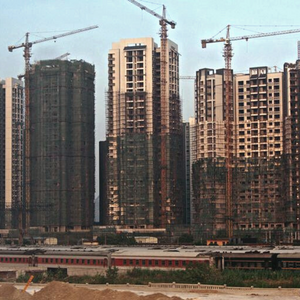As part of the University of Oxford’s Public Engagement through Research award granted to William Allen last year, a series of films was made in collaboration with the University’s School of Anthropology and Museum Ethnography and local film company OxCo. I was very happy to have the opportunity to produce a research film based on my work on Chinese cities. The video itself attempts to take on the difficult, if not naïve task, of deciphering and portraying the process to which cities in China grow and develop – all under 4 minutes. The relegation of describing the city in China as a Messy Reality is both in many ways a simplistic conclusion, but also a realistic one.
As with much of my interests, the inspiration behind the creation of this video was actually driven by an initial annoyance at my own research. In my earlier attempts at creating a coherent literature review for my doctoral thesis, I was constantly stunted by the narrative of a linear interpretation of the Chinese City in the public domain. The story of China’s development is often churned into three stages of (1) socialist city development under Mao (2) reform and growth of cities from special economic zones (such as Shenzhen) (3) and the explosion of urban growth as a result of globalization and urban development.
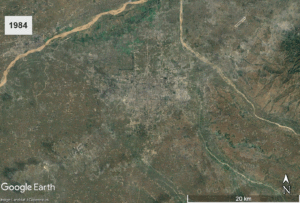
Figure 1: Xi'an’s (Shaanxi) – the outward growth of the city between 1984 and 2020 is seemingly uniform in its expansion.
One similar statistic that is overused in all forms of media, be it academic or within the news, is the fact that China’s urbanization rate has increased from 20% in the 1980s to just under 65% in 2021.
Although, such a narrative is not inaccurate in its description, its simplification can yield assumptions that may lead to misunderstandings and (mis)categorisations of the kind of system that exists within China. When combined with striking images of urban growth, such a statistic of urbanization can easily entrench a perception on Chinese cities.
From a practical perspective, there is rich literature and discussion on what exactly is the Chinese City. I had originally hoped to dig into all the different ways we could interpret the Chinese City, as there are extensive mismatches between the administrative definitions, practical realties and also the different ways people experience urban areas that ultimately make the notion of seeing the city as an existing but almost endless and complex exercise (this example as a visual understanding of how the city can be constantly re-interpreted).
Seeing the Chinese city within this video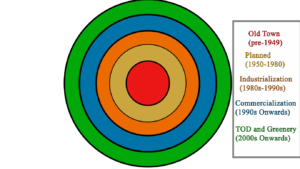
In many ways, much of the intent of my video is also about questioning how we should look at cities in China. It aims at dismantling and preventing an assumptive perception of linear narratives and a direct transition that portray China’s urbanisation from that of village to city. In specific, when we see new stages of urban development, we can often mistakenly assume that they completely replace former stages, which is often far from the reality.
My video, which stems out of an annoyance for such narratives, can introduce those who are unfamiliar with the Chinese City (or visually reintroduce for those who are), to a new way of seeing the urban developmental stages and mismatches and messiness that form what I would argue as resembling the “real” Chinese city.
Being just under 4 minutes long, this video expands on the stages of development we would simplistically assume of a city in China and details the different stages and dominant logics that have appeared throughout. In general, development since the 1980s brings about periods of messiness that we might still be able to see today.
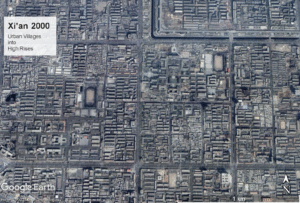
Figure 2: The demolition of Urban Villages in Xi’an, Shannxi
Striking examples can be seen in the development, demolition or regeneration of urban villages – actual villages which where engulfed by the growth of the city. Whereas more recent examples can be found with the creation of new transport stations and hubs. By looking at more micro scale examples we can therefore better deduce the nature of the Chinese City – within these cases as being one defined by its messiness.
Communicating Complexity
This is the first academic video I have produced, and I was reminded in the training workshop that I needed to define my target audience. In truth, I was initially unable pinpoint a specific audience. As academics we so often write for the sake of research and to pursue knowledge, which is why the public engagement with and through research agenda is a new concept for many of us early career researchers. I decided it would therefore be appropriate to create a more introductory video about the Chinese City’s story of development. However, you’ll see that the video has one glaring omission: the lack of people and the experience of those who live within the city. Certainly, within not only an anthropological perspective, but also that of human one; a city is nothing without its occupants and the interactions and rhythms that take place. I had long decided that future video projects would have to better engage with life at the street level and engage with people and their relations to the expansive urban growth and the often complex and structurally incoherent (messy) cities they navigate their life in.
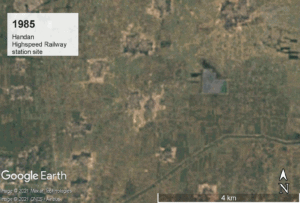
Figure 3: Handan Highspeed Railway Station - Urban Growth only happens after the station has been built and some villages are only half demolished, whereas others grow in size.
This exercise has therefore helped me to identify an audience: those who are coming to Chinese urban development for the first time. For students, ECRs and even journalists looking into China and who may be unfamiliar, this video serves as my argument for a gateway to interpreting Chinese cities beyond a linear narrative of urban transition from villages to cities. In particularly to anyone watching this video, the main message is rooted in the idea that staggered growth in Chinese cities can create extensive messy realities and I would welcome anyone who has watched the video and would like to share or discuss its content to get in touch! As it is my first video, there is still much to learn within the art of communication, so do get in contact!
Kevin Wang is a DPhil candidate in Migration Studies (Anthropology) based at COMPAS. He can be contacted at: kevin.wang@compas.ox.ac.uk
